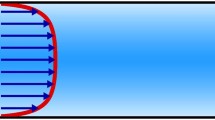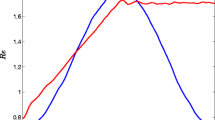Abstract
If the torque exerted on a fluid element and the source of streamwise vorticity generation are analyzed, a turbulence-driven secondary flow is found to be possible in a curved pipe. Based on this analysis, it is found that the secondary flow is primarily induced by high anisotropy of the cross-stream turbulent normal stresses near the outer bend (furthest from the center of curvature of the bend). This secondary flow appears as a counterrotating vortex pair embedded in a Dean-type secondary motion. Recent hot-wire measurements provide some evidence for the existence of this vortex pair. To verify the formation and extent of this turbulence-driven vortex pair further, a near-wall Reynolds-stress model is used to carry out a detailed numerical investigation of a curved-pipe flow. The computation is performed specifically for a U-bend with a full developed turbulent flow at the bend entrance and a long straight pipe attached to the exit. Numerical results reveal that there are three vortex pairs in a curved pipe. The primary one is the Dean-type vortex pair. Another pair exists near the pipe core and is a consequence of local pressure imbalance. A third pair is found near the outer bend and is the turbulence-driven secondary flow. It starts to appear around 60° from the bend entrance, grows to a maximum strength at the bend exit, and disappears altogether at about seven pipe diameters downstream of the bend. On the other hand, calculations of developing laminar curved-pipe flows covering a range of pipe-to-bend curvature ratios, Reynolds number, and different inlet conditions fail to give rise to a third cell near the outer bend. Therefore, experimental and numerical evidence together lend support to the formation of a pair of turbulence-driven secondary cells in curved-pipe flows.
Similar content being viewed by others
References
Agrawal, Y., Talbot, L., and Gong, K. (1978) Laser anemometer study of flow development in curved pipes. J. Fluid Mech. 85, 497–518.
Akiyama, H., Hanaoka, Y., Cheng, K.C., Uroi, I., and Suzuki, M. (1983) Visual measurements of laminar flow in the entry region of a curved pipe. Proc. 3rd Internat. Symp. on Flow Visualization, Ann Arbor (ed. W.J. Yang), pp. 526–530.
Anwer, M., So, R.M.C., and Lai, Y.G. (1989) Perturbation by and recovery from bend curvature of a fully developed turbulent pipe flow. Phys. Fluids A 1, 1387–1397.
Azzola, J., Humphrey, J.A.C., Iacovides, H., and Launder, B.E. (1986) Developing turbulent flow in a U-Bend of circular cross-section: measurement and computation. J. Fluids Engrg. 108, 214–221.
Berger, S.A., Talbot, L., and Yao, L.S. (1983) Flow in curved pipes. Ann. Rev. Fluid Mech. 15, 461–512.
Bradshaw, P. (1987) Turbulent secondary flows. Ann. Rev. Fluid Mech. 19, 53–74.
Cheng, K.C., and Yuen, F.P. (1987) Flow visualization studies on secondary flow patterns in straight tubes downstream of a 180° bend and in isothermally heated horizontal tubes. J. Heat Transfer 109, 49–54.
Choi, U.S., Talbot, L., and Cornet, I. (1979) Experimental study of wall shear rates in the entry region of a curved tube. J. Fluid Mech. 93, 465–489.
Demuren, A.O., and Rodi, W. (1984) Calculation of turbulence-driven secondary motions in noncircular ducts. J. Fluid Mech. 140, 189–222.
Dennis, S.C.R., and Ng, M. (1982) Dual solutions for steady laminar flow through a curved tube. Quart. J. Mech. Appl. Math. 35, 305–324.
Daskopoulos, P., and Lenhoff, A.M. (1989) Flow in curved ducts: bifurcation structure for stationary ducts. J. Fluid Mech. 203, 125–148.
Eckmann, D.M., and Grotberg, J.B. (1988) Oscillatory flow and mass transport in a curved tube. J. Fluid Mech. 188, 509–527.
Enayet, M.M., Gibson, M.M., Taylor, A.M.K.P., and Yianneskis, M. (1982) Laser-Doppler measurements of laminar and turbulent flow in a pipe bend. Internat. J. Heat Fluid Flow 3, 213–219.
Gessner, F.B. (1973) The origin of secondary flow in turbulent flow along a corner. J. Fluid Mech. 58, 1–25.
Gessner, F.B., and Emery, A.F. (1981) The numerical prediction of developing turbulent flow in rectangular ducts. J. Fluids Engrg. 103, 445–455.
Gosman, D.D., and Rapley, C.W. (1978) A prediction method for fully developed flow through non-circular passages. In Numerical Methods in Laminar and Turbulent Flows (ed. C. Taylor et al.), Pentech.
Hornung, H.G. (1988) Vorticity generation and secondary shows. Proc. 1st National Fluid Dynamics Congress, July 25–28, Cincinnati, Ohio (ed. C. Dalton), AIAA, pp. 566–571.
Humphrey, J.A.C., Chang, S.M., and Modavi, A. (1982) Developing turbulent flow in 180° bend and downstream tangent of square cross sections. Report No. LBL-14844, Lawrence Berkeley Laboratory, University of California, Berkeley, California.
Humphrey, J.A.C., Iacovides, H., and Launder, B.E. (1985) Some numerical experiments on developing laminar flow in circular-sectioned bends. J. Fluid Mech. 154, 357–375.
Lai, Y.G. (1990) Near-wall modelling of complex turbulent flows. Ph.D. Thesis, Mechanical and Aerospace Engineering, Arizona State University, Tempe, Arizona.
Lai, Y.G., and So, R.M.C. (1990) On near-wall turbulent flow modelling. J. Fluid Mech. 221, 641–673.
Launder, B.E., and Rodi, W. (1983) The turbulent wall jet—measurements and modelling. Ann. Rev. Fluid Mech. 15, 429–459.
Launder, B.E., Reece, G.J., and Rodi, W. (1975) Progress in the development of a Reynolds stress turbulence closure. J. Fluid Mech. 68, 537–566.
Nandakumar, K., and Masliyah, J.H. (1982) Bifurcation in steady laminar flow through curved tubes. J. Fluid Mech. 119, 475–490.
Olson, D.E., and Snyder, B. (1985) The upstream scale of flow development in curved circular pipes. J. Fluid Mech. 150, 139–158.
Patankar, S.V. (1980) Numerical Heat Transfer and Fluid Flow. McGraw-Hill, New York.
Patankar, S.V., and Spalding, D.B. (1972) A calculation procedure for heat, mass and momentum transfer in three-dimensional parabolic flows. Internat. J. Heat Mass Transfer 15, 1787–1806.
Patankar, S.V., Pratap, V.S., and Spalding, D.B. (1974) Prediction of laminar flow and heat transfer in helically coiled pipes. J. Fluid Mech. 62, 539–557.
Patankar, S.V., Pratap, V.S., and Spalding, D.B. (1975) Prediction of turbulent flow in curved pipes. J. Fluid Mech. 67, 583–595.
Patel, V.C., Rodi, W., and Scheuerer, G. (1985) Turbulence models for near-wall and low-Reynolds-number flows: a review. AIAA J. 23, 1308–1319.
Perkins, H.J. (1970) The formation of streamwise vorticity in turbulent flow. J. Fluid Mech. 44, 721–740.
Rotta, J.C. (1951) Statistische Theorie Nichthomogener Turbulenz. Z. Phys. 129, 547–572; also 131, 51–77.
Rowe, M. (1970) Measurements and computations of flow in pipe bends. J. Fluid Mech. 43, 771–783.
Sforza, P.M., Steiger, M.H., and Trentacoste, N. (1966) Studies on three-dimensional viscous jets. AIAA J. 4, 800–806.
Shima, W. (1988) A Reynolds-stress model for near-wall and low-Reynolds-number regions. J. Fluid Engrg. 110, 38–44.
So, R.M.C., Zhang, H.S., and Lai, Y.G. (1991a) Secondary cells and separation in developing laminar curved-pipe flows. Theoret. Comput. Fluid Dynamics, this issue, pp. 141–162.
So, R.M.C., Lai, Y.G., and Hwang, B.C. (1991b) Near-wall turbulence closure for curved flows. AIAA J. 29, 1202–1213.
Soh, W.Y. (1988) Developing fluid flow in a curved duct of square cross section and its fully developed dual solutions. J. Fluid Mech. 188, 337–361.
Soh, W.Y., and Berger, S.A. (1984) Laminar entrance flow in a curved pipe. J. Fluid Mech. 148, 109–135.
Spalding, D.B. (1972) A novel finite difference formulation for differencing expressions involving both first and second derivatives. Internat. J. Numer. Methods Engrg. 4, 551–559.
Stewartson, K., Cebecci, T., and Chang, K.C. (1980) A boundary-layer collision in a curved duct. Quart. J. Mech. Appl. Math. 33, 59–75.
Yao, L.S., and Berger, S.A. (1975) Entry flow in a curved pipe. J. Fluid Mech. 67, 177–196.
Author information
Authors and Affiliations
Additional information
Communicated by M.Y. Hussaini
Research supported by the Office of Naval Research under Grant No. N0014-81-K-0428 and by the David Taylor Research Center, Annapolis, Maryland, under Contract No. N00167-86-K0075.
Rights and permissions
About this article
Cite this article
Lai, Y.G., So, R.M.C. & Zhang, H.S. Turbulence-driven secondary flows in a curved pipe. Theoret. Comput. Fluid Dynamics 3, 163–180 (1991). https://doi.org/10.1007/BF00271800
Received:
Accepted:
Issue Date:
DOI: https://doi.org/10.1007/BF00271800




